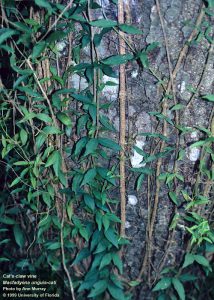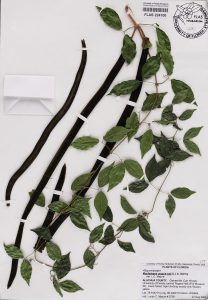Native to the West Indies and Central and South America, cat’s claw vine (Dolichandra unguis–cati) was first introduced to Florida in the 1940’s as a vining, showy ornamental. Thriving in a neotropical climate, it has readily spread through the entire state of Florida and has been listed as a Category I invasive by the Florida Exotic Plant Pest Council (FLEPPC) for well over 15 years.

Belonging to the family Bignoniaceae, alongside other popular woody ornamentals like Jacaranda and Tabebuia, this woody vine (or liana) can reach lengths of up to 15 meters. Highly adapted to a variety of environmental conditions and requiring little input, this invasive species establishes and quickly spreads in a wide range of both disturbed and natural areas such as forest, savanna, and wetland habitats as well as residential gardens and roadsides and agronomic areas like orchards.
It’s opposite, compound leaves consist of three leaflets, one of which has been modified into a 3-pronged tendril. Use of this modified tendril allows cat’s claw vine to attach to surrounding surfaces, dispersing itself high into tree canopies and eventually smothering surrounding vegetation.

The flowers of cat’s claw vine are showy, exhibiting five large, bright yellow petals that are fused to form a trumpet-like shape. Flowers generally occur in April and may persist through the summer. Following pollination, the fruits are elongated, flatted capsules which look very much like string beans. Initially green in color, they will turn dark brown as they mature, cracking open to release up to 50 seeds per seed pod that are readily disperse via wind. But wait, there’s more! This invasive exotic can also spread vegetatively through its thick underground root structure, although seed is said to be the primary means of dispersal.

Of course, we do have a few Florida native look-alikes: yellow jessamine (Gelsemium sempervirens), cross vine (Bignonia capreolata), and trumpet creeper (Campsis radicans). Cross vine and trumpet creeper can be distinguished from cat’s claw vine as they generally produce reddish-orange flowers. Although the flowers of our native yellow jessamine are also similar in color, its leaves are simple and flowering typically occurs in late winter, prior to cat’s claw vine later in the spring.
Listed as a State Noxious Weed, it is now “unlawful to introduce, multiply, possess, move or release any noxious weed or invasive plant regulated by the Florida Department of Agriculture and Consumer Services, except under permit issued by the department”. If you believe you have come across cat’s claw vine, or need advice on how to safely remove it from your property, contact your local county Extension office.
For more information on this invasive plant, check out the following resources: EDIS: Cat’s claw vine, UDSA Weed Risk Assessment, Center for Aquatic and Invasive Plants, and FDACS-DPI Pest Alert: Cat’s claw vine.
To find out where you can purchase some of our native flowering vine species at a local nursery near you, be sure to check out: Florida Association of Native Nurseries – Plant Search.
 0
0
